Preface: the form verification we talked about this time uses the contents of the previous articles, which is more difficult than the previous ones. I will explain it in detail in the form of comments in the code.
catalogue
I Simple form validation
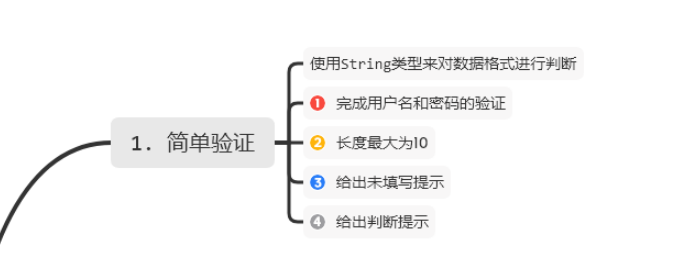
Verification method 1:
<html>
<head>
<meta charset="UTF-8">
<title>Title</title>
<style>
span {
color: red;
font-weight: bold;//Font thickness
}
</style>
</head>
<body>
<form action="" id="myForm">
//Onkey, onkeyup when the key is clicked
<p>name: <input type="text" id="userName" onkeyup="checkName(this)"><span id="l1"></span></p>
<p>password: <input type="text" id="userPwd" onkeyup="checkPwd(this)"><span id="l2"></span></p>
<p>mailbox: <input type="text" id="userEmail" onkeyup="checkEmail(this)"><span id="l3"></span></p>
<p>
<button>Sign in</button>
</p>
</form>
<script>
//Used to check the name for compliance
function checkName() {
/*Define the length of a value to get the value of the name input box*/
var length = userName.value.length
if (length > 0) {//There's something in it
//The size of the name should be between 3-6 (define the length of the value)
if (length >= 3 && length <= 6) {
l1.textContent = "😊"
return true
}
//Out of range
l1.textContent = "Length must be within 3-6 between"
//You must return a value, otherwise it will be overwritten. Return has the function of interruption
return false
}
//There's nothing in it
l1.textContent = "Length must be greater than 0"
return false
}
//Used to check whether the password is compliant
function checkPwd() {
var length = userPwd.value.length
if (length > 0) {//There's something in it
//The size of the name should be between 3-6
if (length >= 3 && length <= 6) {
l2.textContent = "😊"
return true
}
//Out of range
l2.textContent = "Length must be within 3-6 between"
return false
}
//There's nothing in it
l2.textContent = "Length must be greater than 0"
return false
}
//Used to check whether the mailbox is compliant
function checkEmail() {
var length = userEmail.value.length
if (length > 0) {//There's something in it
//The size of the name should be between 3-6
if (length >= 3 && length <= 6) {
l3.textContent = "😊"
return true
}
//Out of range
l3.textContent = "Length must be within 3-6 between"
return false
}
//There's nothing in it
l3.textContent = "Length must be greater than 0"
return false
}
//Add submit event (with return value)
myForm.onsubmit = () => {
//To block the submission of the form, you need to return false
//There are two ways
//First: return checkname() & & checkpwd() & & checkemail()
//Second:
var f1 = checkName()
var f2 = checkPwd()
var f3 = checkEmail()
return f1 && f2 && f3
}
</script>
</body>
</html>Verification method 2:
This is the optimization of the above code
<html>
<head>
<meta charset="UTF-8">
<title>Title</title>
<style>
span {
color: red;
font-weight: bold;
}
</style>
</head>
<body>
<form action="" id="myForm">
<p>name: <input type="text" id="userName" onkeyup="checkLabel(this)"><span><i class="error"></i></span></p>
<p>password: <input type="text" id="userPwd" onkeyup="checkLabel(this)"><span><i class="error"></i></span></p>
<p>mailbox: <input type="text" id="userEmail" onkeyup="checkLabel(this)"><span><i class="error"></i></span></p>
<p>
<button>Sign in</button>
</p>
</form>
<script>
//Used to check compliance
function checkLabel(obj) {
var length = obj.value.length
//The input tag and span tag are both in the p tag. They are brothers and can get the next adjacent element
// var label=obj.nextElementSibling
//Add an i tag to the span tag to get the previous element adjacent to the parent element of the i tag
var label = obj.parentElement.getElementsByClassName("error")[0]
if (length > 0) {//There's something in it
//The size of the name should be between 3-6
if (length >= 3 && length <= 6) {
label.textContent = "😊"
return true
}
//Out of range
label.textContent = "Length must be within 3-6 between"
return false
}
//There's nothing in it
label.textContent = "Length must be greater than 0"
return false
}
//Add submit event (with return value)
myForm.onsubmit = () => {
//To block the submission of the form, you need to return false
// return checkName()&&checkPwd()&&checkEmail()
var f1 = checkLabel(userName)
var f2 = checkLabel(userEmail)
var f3 = checkLabel(userPwd)
return f1 && f2 && f3
}
</script>
</body>
</html>Operation results:
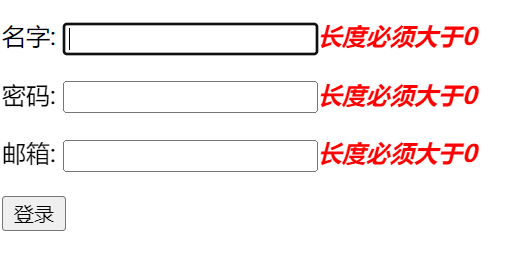
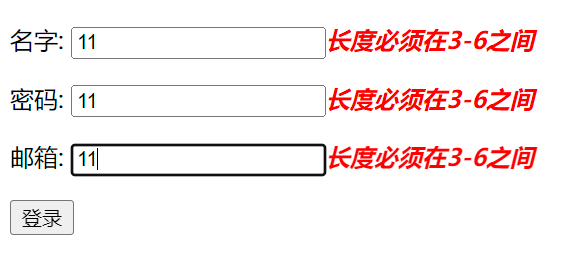
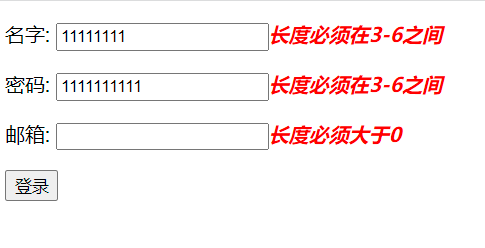
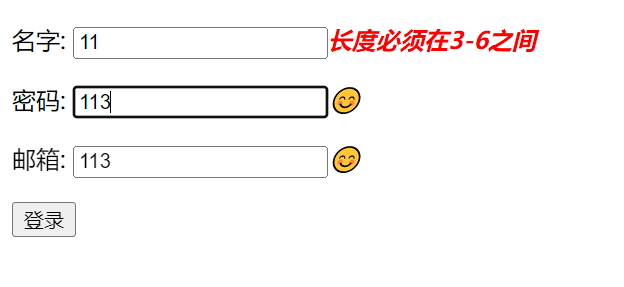
II Regular verification
I believe all of you should know regular expressions, but I still want to talk about regular expressions. Regular expressions are also called regular expressions. They are a logical formula for string operation, that is, using some specific characters defined in advance and the combination of these specific characters to form a "regular string", This "rule string" is used to express a kind of filtering logic for strings.
What can regular expressions be used for?
Given a regular expression and another string, we can achieve the following objectives:
1. Check whether the given string conforms to the filtering logic of regular expression, that is, whether it can match;
2. You can extract or replace specific parts from a string by matching regular expressions.
I Regular rules
Content
| \d | Number [0-9] |
| \D | Non numeric ^ [0-9] |
| \w | Number + English + underline [0-9a-zA-Z_] |
| \W | Non numeric + English + underline ^ [0-9a-zA-Z_] |
| . | Any character |
Times
| ? | 0 ~ 1 times |
| + | At least once |
| * | 0 ~ any time |
| \d{5} | Five numbers (any number) |
| \d{5,10} | At least five times and at most 10 times (fill in any number) |
II Regular precautions
| Must start with / ^ |
| Must end with $/ |
| Don't write \ as\ |
| Define regular objects (for example): var , rex=/^\d{5}$/ |
| Use regular objects (for example): Rex test('123') |
Next, let's write a simple verification using regular
<html>
<head>
<meta charset="UTF-8">
<title>Title</title>
<style>
span {
color: red;
font-weight: bold;
}
</style>
</head>
<body>
<form action="" id="myForm">
<p>name: <input type="text" id="userName" onkeyup="checkLabel(this,/^[a-zA-Z]{3,6}$/,'The length of the name is 3-6')"><span><i class="error"></i></span></p>
<p>password: <input type="text" id="userPwd" onkeyup="checkLabel(this,/^\w{6,10}$/,'The length of the password is 6-10')"><span><i class="error"></i></span></p>
<p>mailbox: <input type="text" id="userEmail" onkeyup="checkLabel(this,/^\w+[.]\w+@\w+[.]\w+$/,'Mailbox must contain@')"><span><i class="error"></i></span></p>
<p>
<button>Sign in</button>
</p>
</form>
<script>
//Used to check compliance
//In parentheses are the values passed in
function checkLabel(obj,rex,tip) {
var length = obj.value.length
var label = obj.parentElement.getElementsByClassName("error")[0]
if (length > 0) {//There's something in it
//Content between regular matches
if (rex.test(obj.value)) {
label.textContent = "😊"
return true
}
//Out of range
label.textContent = tip
return false
}
//There's nothing in it
label.textContent = "Length must be greater than 0"
return false
}
//Add submit event (with return value)
myForm.onsubmit = () => {
//To block the submission of the form, you need to return false
// return checkName()&&checkPwd()&&checkEmail()
var f1 = checkLabel(userName)
var f2 = checkLabel(userEmail)
var f3 = checkLabel(userPwd)
return f1 && f2 && f3
}
</script>
</body>
</html>III Secondary linkage
Does the word secondary linkage sound very advanced, but it is actually very common in our life. You can know what it is at a glance o(T ヘ To)
<html>
<head>
<meta charset="UTF-8">
<title>Title</title>
</head>
<body>
//select drop-down box, provinces, onchange change event
<select id="province" onchange="myChange()"></select>
<select id="cities"></select>
<script>
//Characteristics of JS array
//Unlimited types
//Unlimited length
//Arrays can be strings
var provinces=[]
//city
provinces["Hunan Province"]=["Changsha","Huaihua","Yueyang"]
provinces["Guangxi Province"]=["Guilin","Wuzhou","guest"]
provinces["Zhejiang Province"]=["Hangzhou","Ningbo","Zhoushan"]
//How did the province come from
// for of is equivalent to a foreach traversal element
// for in traversal subscript
for(let i in provinces){
//Add an option to the drop-down box of the province
//appendChild append child node
//<option value="i">i</option>
//The first i is the value and the second i is the displayed value
province.appendChild(new Option(i,i))
}
//Put value in the city
function setCity(name) {
for(let i of provinces[name]){
cities.appendChild(new Option(i,i))
}
}
setCity(province.value)
function myChange() {
//Clear the original option
cities.innerHTML=""
//You can get value in the input box and drop-down box
setCity(province.value)
}
</script>
</body>
</html>Operation results:
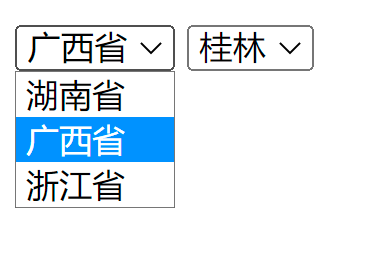
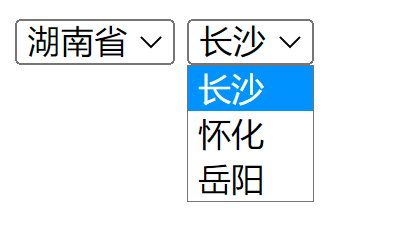
Well, this article is over everywhere. I look forward to seeing you in our next article ( ̄▽  ̄)“